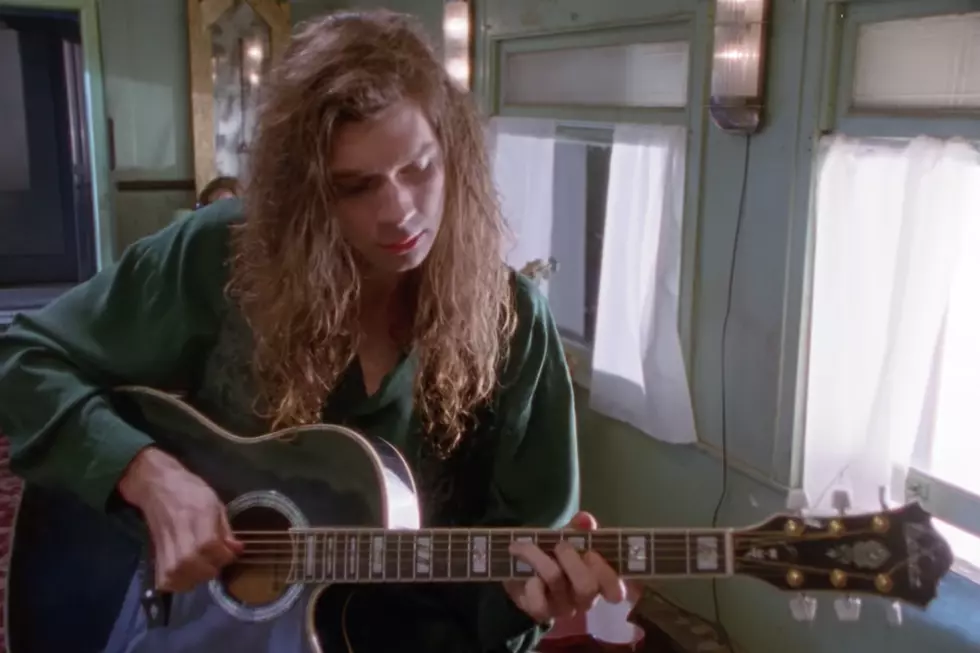
Mr. Big Knew ‘To Be With You’ Success Would Never Happen Again
"You're on top of the world, it's over," guitarist Paul Gilbert recalls with a laugh, thinking back to what manager Herbie Herbert told Mr. Big as their song "To Be With You" was going nuclear on the charts. Even as the band enjoyed the height of their fame, the straight-shooting manager (known for his long association with Journey) worked to realistically map out the group’s future expectations.
In the long run, the San Francisco act would have a career that largely followed the trajectory that Herbert had predicted. Happily, the couple of years of additional popularity that he forecast with their fanbase in Japan stretched out to decades.
The band flourished both collectively and individually, with Gilbert continuing to enjoy guitar hero levels of respect from both musicians and music fans alike. While the future of Mr. Big remains uncertain following the 2018 passing of drummer Pat Torpey from complications of Parkinson's Disease, the remaining members continue to push forward with their own work.
Gilbert is celebrating the spirit of the season with 'TWAS, his new holiday release that mixes both originals and standards in an inventive fashion. He recently spoke with UCR via Zoom -- with his guitar in hand and plugged in -- to talk about the new release as well as the band's landmark 'Lean Into It' album, three decades later.
Here are some excerpts from our conversation, which you can watch in full on the UCR YouTube channel.
Lean Into It ends up being such a massive album for Mr. Big. What was the scene as you all were looking at recording this album, your sophomore release?
We had been on tour. We got some really good tours and we did a lot of touring with Rush. I just remember feeling like we would have gotten a better reaction if our songs were more melodic. Somehow, that’s what I took away from the experience. We’d go out there and have this great audience in front of us and we’d just do okay.
So for me, that was the goal. It was like, let’s get some melody in there. It’s still fine if it’s got bluesy style, but let’s make sure the songs themselves have stronger melodies. Eric [Martin] came and hit it out of the park. He had “Just Take My Heart” and “To Be With You.” I came up with “Green Tinted Sixties Mind.”
To me, those three and maybe, “CDFF-Lucky This Time,” were really melodic. We’re [also] in major keys, so that was a big difference. The rockers were good too. You know, “Daddy, Brother, Lover, Little Boy (The Electric Drill Song)” had a good energy to it. “Alive and Kickin’,” even though it was bluesy, it still had harmonies. The whole record just flowed well. The sounds were good and the planets aligned for us.
How early did the drill come into the picture for “Daddy, Brother, Lover, Little Boy (The Electric Drill Song)”?
I can’t remember exactly. You know, I’d been doing that once in a while and we rustled up another one for Billy [Sheehan]. We thought, wouldn’t it be amazing with harmony? I think a lot of that sort of thing or the shreddy stuff that we would do was put together so quickly, which always surprised me.
With Racer X, we would rehearse for months and really be meticulous about all of that stuff. With Mr. Big, it was always like, “Okay, we’ve got five minutes” and we’d just throw it together. When you go to the toolbox of stuff that you know is going to work, you only need five minutes. Because that’s where you’re fluent.
So it wasn’t like we were doing something easy, we were just doing stuff that was comfortable, which we already knew how to do. Because of that, it always works well live and it came across with a strength that was nice.
Watch Mr. Big's 'Daddy, Brother, Lover, Little Boy (The Electric Drill Song)'
I don't think that anybody was predicting in 1991 that you guys and Van Halen, would both employ drills as a featured instrument.
Oh, that was surreal. Because you know, I was and still am, the biggest Van Halen fan. It really felt unreal to turn on MTV [and see the video for "Poundcake"]. I’m going, “What is going on?” I suppose I’m still in that state of mind.
You mentioned "Alive and Kickin'," which has such a great hook. How did that one come together?
My memory of “Alive and Kickin’” is that I had the really basic riff. Billy said, “Can you do it and play over these changes? Not only in G, but if I play a C note, can you modify the riff to fit that?” It wasn’t set up for that, so my first thought was, “No, that’s not going to work.” Then I took it home and just started twisting it and turning it until it fit. That was cool, because then the thing that I ended up coming up with was something that was unusual, but it worked. It was unusual for a reason rather than just arbitrary unusualness.
What's cool about the album is it still sounds great, the way that it was recorded. It doesn't sound overly dated like some albums from the era do.
The tom toms are unbelievable. On “Green Tinted Sixties Mind,” [sings section of the song], I mean, those are the days before...I don’t think we did any samples. Because it took a lot to do that. Now, with Pro Tools, you can sound replace and do anything with the press of a button. Back then, it was tricky to do that, so we actually had to get a good sound.
Overall, what's your favorite memory from making that record?
I had a really horrible car. Herbie Herbert, who passed away recently, he had come down. He owned the production company that was doing the video screens for Michael Jackson. So Herbie came down to see Michael Jackson. Billy had a Corvette and you know, a Corvette only holds two people and the three of us wanted to go. So that left us with my horrible car. We’re driving down the 405 and it’s a pretty long drive, because it was in Irvine Meadows or some venue in Orange County and we’re coming from Hollywood.
We get about 20 minutes into the drive and steam starts coming out of my front end, because I didn’t know about maintenance. I remember looking at it going, “Is that me?” And Billy’s going, “Yeah, uh-huh, that’s you.” We pulled over and somehow managed to get the car fixed at the gas station and kept on going. After that, Herbie was like, "I’ve gotta get this kid a publishing deal." So Herbie got me a publishing deal and as soon as the money came in, he’s like, “Go buy a car!” I didn’t know how to buy a car.
Because when I was a kid, all I did was play guitar. So I went out on my balcony and started watching the road. I thought “Well, this is how you learn what kind of car you want.” You just watch the road until something drives by that you like. I liked all of the old cars with fins. So I ended up buying a ‘62 Thunderbird. Which was like the most dangerous [car]. The brakes never worked. It’s a miracle that I’m alive, because I ran so many stoplights, [because I was] pumping the brakes and nothing was happening.
But it looked cool and had a great stereo. I just remember riding in that ‘62 T-Bird to the studio every day and just thinking that life was grand, because I was excited about the songs. It really felt like something was going to happen with the record. And I’m thinking, “Man, someday, I might even have a girlfriend after this record comes out.” If my brakes will work, everything is solved.
Herbie Herbert was a character. What's your favorite Herbie story?
While “To Be With You” was a hit, he flew out to have a meeting with us, because we were on tour. He sat us all down and he said, “Guys, this is amazing. This is wonderful. Let’s celebrate. By the way, this is never, ever, going to happen to you again.” He said, “The industry is changing. The problem is that you guys don’t dance and you’re not women and that’s the future. None of you are Janet Jackson. You’re screwed. That’s what MTV is going to play from now on. They don’t want a bunch of guitar playing skinny guys. So go play in Japan, they’ll still like you there for a couple of years, probably. Make the most of it.” But basically, he said, “You’re on top of the world, you’re over.” [Laughs]
And of course, he was right. But the other thing that he said was, “Don’t complain about all of the work. This is your chance to be on David Letterman, The Tonight Show and it’s not going to happen again, so quit your whining. You’ll sleep next year. Right now, you’re busy, so take advantage of it, because this is it.
I really appreciate how you put your own stamp on the songs you recorded for 'TWAS, your new holiday album. What was your guide inspirationally as far as making a holiday album that you thought people would enjoy?
I found myself gravitating to older recordings. I really liked Nat King Cole's recordings. Loretta Lynn has a great country Christmas album and I love some of her stuff -- and even Elvis [Presley]. You know, the stuff that was recorded in the '40s, '50s and '60s, that tended to be where I was spending the most time listening.
When you get back into that era, a lot of the orchestration is pretty sophisticated. You know, whoever was writing the string arrangements for Nat King Cole's versions of these Christmas songs, really knew what they were doing. That's like a real musician doing that stuff. You know, for the whole orchestra and [with] all of these huge harmony vocals going on.
For my band, I wanted to get a blues rhythm section, so it would groove. And I got jazz guys, a jazz guitar player named Dan Balmer and a jazz keyboard player, Clay Giberson. I would bring them over and say, "I love this Nat King Cole version, can you guys figure out the chords." Because I probably could, you know, I've been to school and I know the chords, but I don't spend that much time with that stuff, so it would take me a long time. I could do in two days what they could do in 45 minutes.
I didn't have two days to spend on every song, so I'd have them come over, they'd chart it out and then, you know, I'm not doing anything [major], I'm just doing the melody on top, while they're doing all of the cool stuff underneath. [Laughs] They did that to a few of the songs and then some of them, actually, I did have my own inspiration.
"Let It Snow! Let It Snow! Let It Snow!" is one of them, where the melody itself, you can arrange it to be very simple [demonstrates riffing], but I ended up taking [a different approach]. It was funny too, because I wrote it on a chart and all of those guys can read. It's the first time I've written charts. Because you know, most of the time, playing with rock musicians, we just do it by ear. But I realized, everybody in my band can read. If I can only learn to write.... [Laughs]
And it's not the little dots, you know, I just write the chord charts, but it was interesting to do that. Because you can get the point across if you're fluent enough to write it down, they read it and they get it right. We were able to work pretty quickly that way. We only spent six days recording and we got 12 songs and a bonus track for Japan, with some fairly sophisticated arrangements.
Listen to 'Let It Snow! Let It Snow! Let It Snow!' by Paul Gilbert
Top 30 Glam Metal Albums
More From Ultimate Classic Rock









